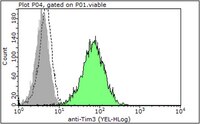Combined blockade of TIM-3 and TIM-4 augments cancer vaccine efficacy against established melanomas.
Baghdadi, Muhammad, et al.
Cancer Immunol. Immunother., 62: 629-37 (2013)
2013
Afficher le résumé
Cancer vaccines have been developed to instruct the endogenous immune responses to autologous tumors and to generate durable clinical responses. However, the therapeutic benefits of cancer vaccines remain insufficient due to the multiple immunosuppressive signals delivered by tumors. Thus, to improve the clinical efficacy of cancer immunotherapy, it is important to develop new modalities to overcome immunosuppressive tumor microenvironments and elicit effective antitumor immune responses. In this study, we show that novel monoclonal antibodies (mAbs) specifically targeting either T cell immunoglobulin mucin protein-3 (TIM-3) or T cell immunoglobulin mucin protein-4 (TIM-4) enhance the therapeutic effects of vaccination against established B16 murine melanomas. This is true for vaccination with irradiated B16 melanoma cells engineered to express the flt3 ligand gene (FVAX). More importantly, combining anti-TIM-3 and anti-TIM-4 mAbs markedly increased vaccine-induced antitumor responses against established B16 melanoma. TIM-3 blockade mainly stimulated antitumor effector activities via natural killer cell-dependent mechanisms, while CD8(+) T cells served as the main effectors induced by anti-TIM-4 mAb. Our findings reveal that therapeutic manipulation of TIM-3 and TIM-4 may provide a novel strategy for improving the clinical efficacy of cancer immunotherapy. | 23143694
 |
Tumor-infiltrating DCs suppress nucleic acid-mediated innate immune responses through interactions between the receptor TIM-3 and the alarmin HMGB1.
Chiba, Shigeki, et al.
Nat. Immunol., 13: 832-42 (2012)
2011
Afficher le résumé
The mechanisms by which tumor microenvironments modulate nucleic acid-mediated innate immunity remain unknown. Here we identify the receptor TIM-3 as key in circumventing the stimulatory effects of nucleic acids in tumor immunity. Tumor-associated dendritic cells (DCs) in mouse tumors and patients with cancer had high expression of TIM-3. DC-derived TIM-3 suppressed innate immune responses through the recognition of nucleic acids by Toll-like receptors and cytosolic sensors via a galectin-9-independent mechanism. In contrast, TIM-3 interacted with the alarmin HMGB1 to interfere with the recruitment of nucleic acids into DC endosomes and attenuated the therapeutic efficacy of DNA vaccination and chemotherapy by diminishing the immunogenicity of nucleic acids released from dying tumor cells. Our findings define a mechanism whereby tumor microenvironments suppress antitumor immunity mediated by nucleic acids. | 22842346
 |
Preferential involvement of Tim-3 in the regulation of hepatic CD8+ T cells in murine acute graft-versus-host disease.
Oikawa, Tsunekazu, et al.
J. Immunol., 177: 4281-7 (2006)
2005
Afficher le résumé
Tim-3, a member of the T cell Ig mucin (TIM) family regulates effector Th1 responses. We examined Tim-3 and its ligand expression as well as the effects of anti-Tim-3 mAb treatment in a murine model of acute graft-vs-host disease (aGVHD). In mice with aGVHD, Tim-3 expression was markedly up-regulated on splenic and hepatic CD4+ and CD8+ T cells, dendritic cells (DCs), and macrophages, and this was especially dramatic in hepatic CD8+ T cells. Both donor- and host-derived CD8+ T cells induced similar levels of Tim-3. Tim-3 ligand expression was also up-regulated in splenic T cells, DCs, and macrophages, but not in the hepatic lymphocytes. The administration of anti-Tim-3 mAbs accelerated aGVHD, as demonstrated by body weight loss, reduction in total splenocyte number, and infiltration of lymphocytes in the liver. IFN-gamma expression by splenic and hepatic CD4+ and CD8+ T cells was significantly augmented by anti-Tim-3 mAb treatment. In addition, the cytotoxicity against host alloantigen by donor CD8+ T cells was enhanced. These results demonstrate that the anti-Tim-3 treatment in aGVHD augmented the activation of effector T cells expressing IFN-gamma or exerting cytotoxicity. Our results suggest that Tim-3 may play a crucial role in the regulation of CD8+ T cells responsible for the maintenance of hepatic homeostasis and tolerance. | 16982862
 |















trimethylsilane[818557_(Chloromethyl)trimethylsilane-ALL].jpg)

